Creating a Learning Environment through Electronic Media combined with Blended Learning in the First Aid and Basic Medical Care Course
Keywords:
Learning Environment, e-learning, Blended Learning, First Aid and Basic Medical CareAbstract
This research and development aimed to design and evaluate a learning environment through electronic media, combined with blended learning in the First Aid and Basic Medical Care Course. The research process was divided into three phases: Phase 1, creating the learning environment through electronic media combined with blended learning; Phase 2, implementing with setting up a learning environment through electronic media combined with blended learning; and Phase 3: evaluation stage. The study was conducted among all 86 students enrolled in the First Aid and Basic Medical Care Course. Statistics used in data analysis were percentage, mean, standard deviation; and paired t-test.
The results showed that the learning environment through electronic media combined with blended learning consisted of four steps: 1) preparation before going to practice in the field work by using blended learning activities, includes teaching the skills necessary for studying in the course so that students can share their learning with teachers and peers, and also practicing in the classroom 2) self-learning by teaching through the e-learning system 3) practice in a training center and 4) assessing and reinforcing deficiencies in required skills by using blended learning activities. Assessment of the learning environment through electronic media combined with blended learning, found that the scores in the e-learning system, the first skill reinforcement score, the assigned training, the second reinforcement exercise, and the total scores were significantly different from the scores on criteria that were required to pass 60 percent of the scores on each activity statistically.
References
ข้อบังคับสภาการสาธารณสุขชุมชน (2563). หลักเกณฑ์และเงื่อนไขการตรวจประเมินและการบำบัดโรคเบื้องต้น การดูแลให้ความช่วยเหลือผู้ป่วย การสร้างเสริมภูมิคุ้มกันโรค และการวางแผนครอบครัว. ราชกิจจานุเบกษา, 137(137ง), 92-94.
ธีระชล สาตสิน และศรีสุดา วงศ์วิเศษกุล. (2564). ถอดบทเรียนการสอนออนไลน์: ความท้าทายสำหรับอาจารย์ในสถานการณ์โรคโควิด 19. วารสารพยาบาลทหารบก. 22(1), 1-9.
เพ็ญจันทร์ แสนประสาน วรณิช พัวไพโรจน์และพวงทิพย์ ชัยพิบาลสฤษดิ์ (2558). ผลการใช้แนวคิดการสร้างความรู้ด้วยตนเองในการเรียนการสอนรายวิชา กระบวนการพยาบาลและการประเมินภาวะสุขภาพ. วารสารพยาบาลโรคหัวใจและทรวงอก, 26(1), 149–164.
วณิชา พึ่งชมพูและศิริรัตน์ ปานอุทัย (2557). การพัฒนารูปแบบการเรียนการสอนด้วย E-Learning สำหรับนักศึกษาพยาบาลศาสตร์ในกระบวนวิชาการพยาบาลผู้สูงอายุ. พยาบาลสาร, 41(5), 11–25.
ศิริจิตร จันทรและธัญลักษณ์ บรรลิขิตกุล (2555) ประเมินความพร้อมในการฝึกปฏิบัติในรายวิชาปฏิบัติการพยาบาลพื้นฐานของนักศึกษาพยาบาล วิทยาลัยพยาบาลสภากาชาดไทย. วารสารพยาบาลสภากาชาดไทย. 5(1).32-45.
Abrusch, J., Marienhagen, J., Böckers, A., & Gerhardt-Szép, S. (2015). Quality management of eLearning for medical education: Current situation and outlook. GMS Zeitschrift Fur Medizinische Ausbildung, 32(2), Doc20. https://doi.org/10.3205/zma000962
Choules, A. P. (2007). “The Use of Elearning in Medical Education: A Review of the Current Situation.” Postgraduate Medical Journal 83(978):212–16.
George, P. P., Papachristou, N., Belisario, J. M., Wang, W., Wark, P. A., Cotic, Z., & Car, J. (2014). Online eLearning for undergraduates in health professions: A systematic review of the impact on knowledge, skills, attitudes and satisfaction. Journal of Global Health, 4(1), 010406.
Maginnis, C., & Croxon, L. (2010). Transfer of learning to the nursing clinical practice setting. Rural and Remote Health, 10(2), 1313.
Rasmussen, K., Belisario, J. M., Wark, P. A., Molina, J. A., Loong, S. L., Cotic, Z., Car, J. (2014). Offline eLearning for undergraduates in health professions: A systematic review of the impact on knowledge, skills, attitudes and satisfaction. Journal of Global Health, 4(1), 010405.
Sissine, M., Segan, R., Taylor, M., Jefferson, B., Borrelli, A., Koehler, M., & Chelvayohan, M. (2014). Cost Comparison Model: Blended eLearning versus traditional training of community health workers. Online Journal of Public Health Informatics, 6(3), e196.
Xu, J. (2016). Toolbox of teaching strategies in nurse education. Chinese Nursing Research, 3(2), 54–57.
Downloads
Published
How to Cite
Issue
Section
License
Disclaimer and Copyright Notice
The content and information presented in articles published in the Journal of Law and Public Health Policy represent the opinions and sole responsibility of the respective authors. The editorial board does not necessarily agree with or assume any responsibility for the views expressed.
All articles, data, content, images, and other materials published in the Journal of Law and Public Health Policy are the intellectual property of the journal. Any individual or organization wishing to reproduce, distribute, or otherwise use the entirety or any part of such materials must provide proper citation.





